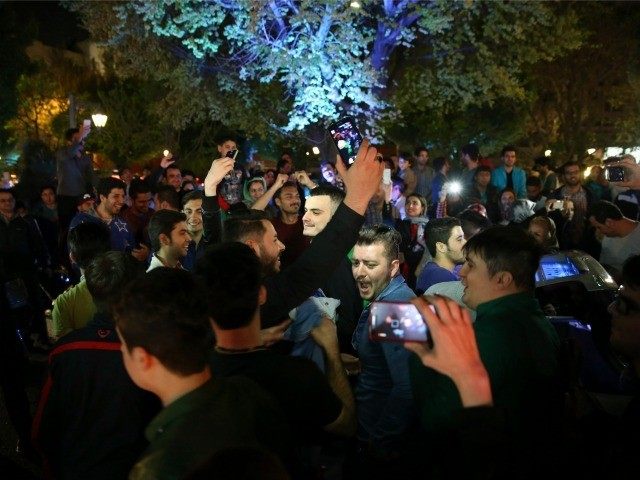One short week ago, the world watched as the media presented images and videos of Iranian youth dancing, celebrating and passing out sweets in the streets of Tehran over Foreign Minister Javad Zarif’s announcement of a tentative nuclear framework deal with America that would allegedly “terminate” U.S. and E.U. sanctions on the country.
Many across the globe wondered why.
The disconnected observer over 7,000 miles away in North America could easily arrive at all sorts of conclusions to explain why the group of young men were dancing with Iranian flags between lines of cars being driven by women who let their chadors (head scarves) recline to the backs of their necks, their hair flapping in the night’s breeze–an offense for which one could ordinarily be arrested
Some likely assumed the festive atmosphere had something to do with buzz surrounding the Islamic Republic’s intent to acquire nukes and increase its hegemony in the region. Another casual observer might even flash to the over 36 years of the recitation of “death to America” since Ayatollah Ruhollah Khomeini solidified his presence on the scene in 1979.
There is another side to the story that few outsiders were able to identify–a side that consists of a people, just like any other population in the world, steeped in dim glimmers of hope and which stands in stark opposition to the very government which brought them the news over which they had rejoiced, the same government that oppresses them to seemingly no end, with the exception of the wealthy, who can pay their way around the system’s endless corruption.
“Sure, a lot of people are celebrating, but we’re really just celebrating the fact that we’re back at zero again,” a 27-year-old law student named Ardeshir told the Guardian. More than half of Iran’s population is unemployed or living in poverty. New York magazine points to a 2012 estimate by E.U. adviser Mehrdad Emadi, which reported that 40% of men working in Iran’s largest cities lost their jobs. It was the result of crippling economic sanctions on the Islamic Republic, which were successful in preventing the regime’s proliferation and greatly weakening its stronghold.
But the opportunity for tangible regime change had come and gone with 2009’s Green Revolution, when the opposition was crushed by the Iranian Revolution Guards Corps. (The IRGC is known as “Sepah” in the Islamic Republic.)
The sanctions played a sizable role in prompting the Iranian government to come to the table to negotiate. Then again, so did the $12 billion of their own sanctioned funds that President Obama presented to the regime to bring it to the table for talks; that amount is enough to pay for two years worth of the $5.6 billion annual salary of the IRGC, Michael Rubin of the American Enterprise Institute told Breitbart News.
While outlets like New York argue that “sanctions are almost always the wuss option” in Washington, D.C., their effect is far more severe on the receiving end. And a side of the celebrations that the mainstream media did not report is the fact that close to 200 men holding hand-written signs were counter-protesting the seemingly thousands of celebrators outside of Iranian Parliament.
New York magazine described it as being “pretty lifeless by comparison.” Still, that group was emblematic of a side that was likely aware, deep down, that the potential release of $150 billion in frozen assets from Iran’s Central Bank would indeed grant a degree of permanence to the clerical regime–a crushing defeat for any potential oppositional uprising from within.
For a society that has very little about which to be optimistic, it comes as no surprise then that they would react so joyously to this glimmer of hope that had been placed in their path: a handshake perhaps to indicate that the people of Iran could somehow better themselves economically and be liberated from a regime which has brought crippling sanctions upon itself through its history of lies and scheming operations.
The world should not forget that these sparks of liberation are the mirage of an oasis in a parched desert land–the celebrating Iranians may appear at a distance to be the green shoots of a free civil society, but they live in a country that not too long ago threw six young people in jail for dancing on video to Pharrell’s hit song “Happy.” The human rights abuses persist.
In the end, the people of Iran have their hope. And so long as the regime remains in place, that is all they will have.
Follow Adelle Nazarian on Twitter @AdelleNaz.

COMMENTS
Please let us know if you're having issues with commenting.